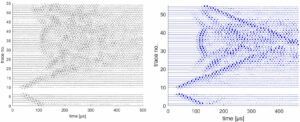Contract person: Fabian Dethof
During condition assessment of a structure often non-destructive testing is conducted. Some of the non-destructive testing methods are based on elastic wave propagation. With the project normPOD we are investigating those non-destructive testing methods impact echo and ultrasonic inspection, which are based on elastic wave propagation, in regard to their reliability. A reliability assessment is important, because a defect might remain undetected under certain circumstances if its size lies below a certain threshold. Fort hat reason usually a probability of detection (POD) is introduced, which gives the likelihood of a defect of a certain size to be detected. The POD depends on factors like the used measurement equipment or the level of noise in the signals. Every inspection method also has a separate POD.
The goal for impact echo testing is to determine the thickness of plate-like structures and to detect defects like cracks or honeycombing in such. Therefore a small mechanical pulse is generated at one side of the investigated specimen. This pulse then propagates inside the specimen and will be reflected by the back wall or other heterogeneities like defects. Due to the multiple reflections at both sides of the specimen, a resonance frequency can be measured near the impact point, which is used to judge the damage condition and thickness at that point.
For ultrasonic inspection also a pulse of elastic waves will be generated. In contrast to the impact echo method however, the wavelength of this pulse will be much smaller. As a result the waves will be scattered at smaller heterogeneities giving a complex reflection pattern. The goal for this inspection method is to determine the structure of the inspected specimen as well as material parameters like wave propagation speed.
Fabian Dethof‘s Task in this project is to conduct numerical simulations of elastic wave propagation in reinforced concrete. As the main simulation tool the elastodynamic finite integration technique EFIT is being used. It is capable of performing stable, large-scale 3D simulations of strongly heterogeneous media like concrete. The goal for the simulations is to get a better understanding about the wave propagation during these inspection method, determine the most influencial factors during these inspections and quantify their impact on the probability of detection (POD) for defects.

Letzte Änderung: 11. April 2022